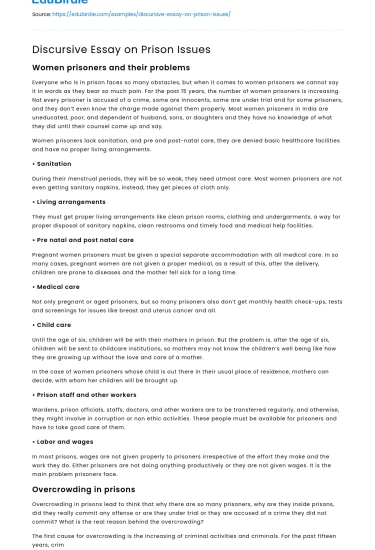Introduction
The prison system is a fundamental component of the criminal justice framework, yet it remains a contentious issue due to its multifaceted nature. Prisons are intended to serve several purposes, including punishment, deterrence, rehabilitation, and societal protection. However, the efficacy and morality of these objectives are frequently debated. This essay aims to explore various issues associated with prison systems, focusing on overcrowding, recidivism, and rehabilitation challenges. By examining these elements, we can gain a deeper understanding of the complexities surrounding prisons and consider potential reforms. Through a discursive approach, this paper will present arguments for and against the current state of prison systems, supported by real-life examples and scholarly opinions, ultimately advocating for a more balanced and humane approach to incarceration.
The Issue of Overcrowding
Prison overcrowding is a critical issue that plagues many correctional facilities worldwide. The proliferation of stringent sentencing laws, such as mandatory minimums and "three strikes" policies, has led to an exponential increase in the prison population. According to the World Prison Brief, the United States has one of the highest incarceration rates globally, with over two million individuals currently behind bars. Overcrowding exacerbates numerous problems within prisons, including violence, limited access to healthcare, and inadequate living conditions. For instance, in California, the Supreme Court mandated the state to reduce its prison population due to inhumane conditions resulting from overcrowding (Brown v. Plata, 2011).
Save your time!
We can take care of your essay
- Proper editing and formatting
- Free revision, title page, and bibliography
- Flexible prices and money-back guarantee
Critics argue that overcrowding undermines the rehabilitative purpose of incarceration, as resources become stretched thin. The lack of space and programming opportunities inhibits prisoners' ability to engage in educational and vocational training, crucial for successful reintegration into society. Conversely, proponents of strict sentencing assert that such measures deter crime and protect society. However, studies, such as the one conducted by the National Research Council, have shown that increased incarceration rates have minimal impact on crime reduction. Therefore, it is essential to reconsider sentencing policies and explore alternative methods, such as community-based programs, to alleviate overcrowding and enhance the prison system's effectiveness.
Recidivism and Rehabilitation Challenges
Recidivism, the tendency of previously incarcerated individuals to reoffend, poses a significant challenge to the effectiveness of prison systems. High recidivism rates indicate that prisons often fail to rehabilitate offenders, raising questions about their role in society. The Bureau of Justice Statistics reports that approximately 68% of released prisoners in the United States are rearrested within three years. This alarming statistic highlights the inadequacy of current rehabilitation efforts within correctional facilities.
Rehabilitation programs, when effectively implemented, can reduce recidivism rates and support successful reintegration. Educational and vocational training, cognitive-behavioral therapy, and substance abuse programs are essential components of a comprehensive rehabilitation strategy. However, underfunding and lack of access to these programs often curtail their potential impact. The Norwegian prison system, known for its focus on rehabilitation, offers a contrasting example. With an emphasis on humane treatment and skill development, Norway boasts one of the lowest recidivism rates globally, at approximately 20% (Sterbenz, 2014).
While some advocate for more punitive measures, arguing that harsh conditions serve as a deterrent, evidence suggests otherwise. The American Psychological Association highlights that punitive approaches may exacerbate criminal behavior rather than mitigate it. Therefore, investing in rehabilitation and addressing the underlying causes of criminal behavior are crucial steps towards reducing recidivism and enhancing public safety.
Transitioning Towards Reform
The necessity for prison reform is underscored by the challenges of overcrowding and recidivism, which reveal systemic flaws in the current model. Transitioning towards a reformed system involves addressing these issues through innovative approaches and policy changes. One potential avenue for reform is the implementation of restorative justice practices, which focus on repairing the harm caused by criminal behavior through reconciliation and community involvement. Programs that emphasize accountability and restitution have shown promise in reducing recidivism rates and fostering a sense of responsibility among offenders.
Moreover, the decriminalization of certain offenses, particularly non-violent drug-related crimes, could significantly reduce the prison population. Portugal's approach to drug decriminalization, which prioritizes treatment over incarceration, has led to a decrease in drug-related crimes and an improvement in public health outcomes (Hughes & Stevens, 2010). By reallocating resources from incarceration to prevention and treatment programs, governments can address the root causes of criminal behavior and promote societal well-being.
Conclusion
In conclusion, the complexities of the prison system demand a nuanced understanding and a balanced approach to reform. Overcrowding, recidivism, and rehabilitation challenges are interlinked issues that necessitate comprehensive solutions. By examining successful models from other countries and considering alternative policies, such as restorative justice and decriminalization, we can work towards a more effective and humane correctional system. While the path to reform is fraught with challenges, it is essential for ensuring that prisons fulfill their intended roles in society. Ultimately, a prison system that prioritizes rehabilitation, addresses systemic issues, and promotes reintegration will benefit not only the individuals involved but also the broader community.






 Stuck on your essay?
Stuck on your essay?

